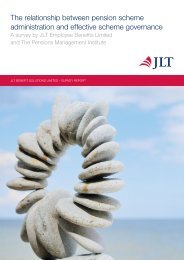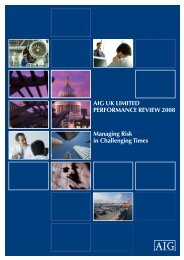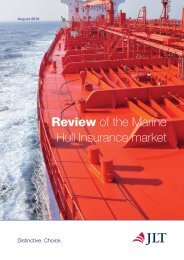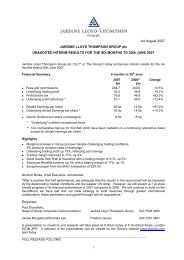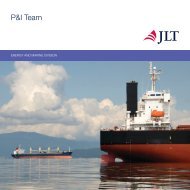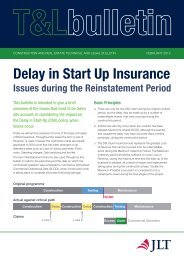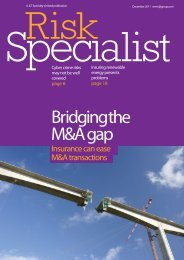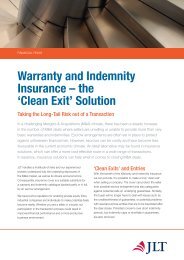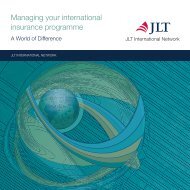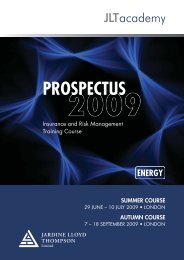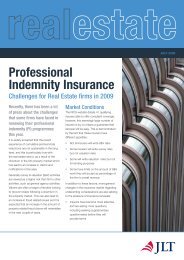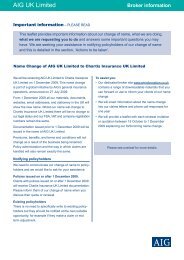Report & Accounts - JLT
Report & Accounts - JLT
Report & Accounts - JLT
- No tags were found...
You also want an ePaper? Increase the reach of your titles
YUMPU automatically turns print PDFs into web optimized ePapers that Google loves.
Financial StatementsAccounting PoliciesDerivative Financial InstrumentsThe Group only enters into derivative financial instruments in order to hedge underlying exposures.Prior to 1st January 2005, forward rate agreements, interest rate swaps and options were held off balance sheet and receipts andpayments on settlement of these instruments were recognised as adjustments to investment income on an accruals basis over thelife of the hedge.Changes to the fair value of foreign exchange contract held as a hedge against transactional exposure were not recognised untilthe maturity of the underlying contract.56Subsequent to 1st January 2005, derivative financial instruments are initially recognised at fair value on the date a derivativecontract is entered into and are subsequently re-measured at their fair value. The method of recognising the resulting gain or lossis dependent on the nature of the item being hedged. The Group designates certain derivatives as either a hedge of the fair valueof a recognised asset or liability (fair value hedge), or a hedge of a forecasted transaction or of the foreign currency risk on a firmcommitment (cash flow hedge), or a hedge of a net investment in a foreign entity.Changes in the fair value of derivatives that are designated and qualify as fair value hedges and that are highly effective, arerecorded in the consolidated income statement, along with any changes in the fair value of the hedged asset or liability that isattributable to the hedged risk.Changes in the fair value of derivatives that are designated and qualify as cash flow hedges and that are highly effective, arerecognised in hedging reserves. Where the forecasted transaction or firm commitment results in the recognition of a non-financialasset or of a non-financial liability, the gains and losses previously deferred in hedging reserves are transferred from hedgingreserves and included in the initial measurement of the cost of the asset or liability. Otherwise, amounts deferred in hedgingreserves are transferred to the consolidated income statement and classified as income or expense in the same periods duringwhich the hedged firm commitment or forecasted transaction affects the consolidated income statement.When a hedging instrument expires or is sold, or when a hedge no longer meets the criteria for hedge accounting, any cumulativegain or loss existing in hedging reserves at that time remains in the hedging reserves and is recognised when the committed orforecasted transaction ultimately is recognised in the consolidated income statement. When a committed or forecasted transactionis no longer expected to occur, the cumulative gain or loss that was reported in hedging reserves is immediately transferred to theconsolidated income statement.Dividend distributionDividends proposed or declared after the balance sheet date are not recognised as a liability at the balance sheet date.Final dividends are recognised as a charge to equity once approved and interim dividends are charged once paid.Jardine Lloyd Thompson Group plc Annual <strong>Report</strong> & <strong>Accounts</strong> 2005Critical Accounting Estimates and JudgementsEstimates and judgements used in preparing the financial statements are continually evaluated and are based on historicalexperience and other factors, including expectations of future events that are believed to be reasonable. The resulting accountingestimates will, by definition, seldom equal the related actual results. The estimates and assumptions that have a significant effecton the carrying amounts of assets and liabilities are discussed below.a) Property, plant and equipmentAssets are carried at historical cost less depreciation calculated to write off the cost of such assets over their estimated usefullives.Management determines the estimated useful lives and related depreciation charges at acquisition. The estimated useful life isreviewed annually and the depreciation charge is revised where useful lives are subsequently found to be different to thosepreviously estimated.b) Impairment of assetsThe Group tests annually whether goodwill and other assets that have indefinite useful lives suffered any impairment. Otherassets are reviewed for impairment whenever events or changes in circumstances indicate that the carrying amount of theasset exceeds its recoverable amount. The recoverable amount of an asset or a cash-generating unit is determined based onvalue-in-use calculations prepared on the basis of management’s assumptions and estimates. This determination requiressignificant judgement. In making this judgement, the Group evaluates, among other factors, the duration and extent to whichthe fair value of an investment is less than its cost; and the financial health of and near-term business outlook for theinvestment, including factors such as industry and sector performance, changes in regional economies and operational andfinancing cash flow.



